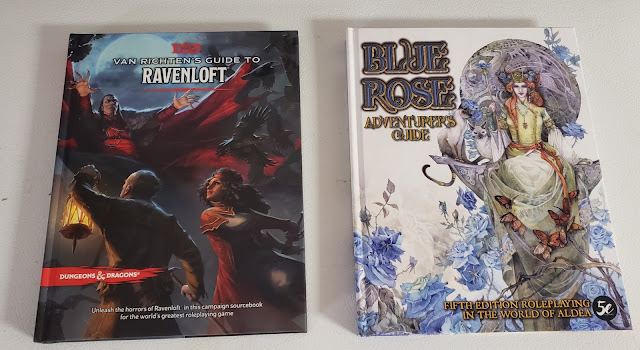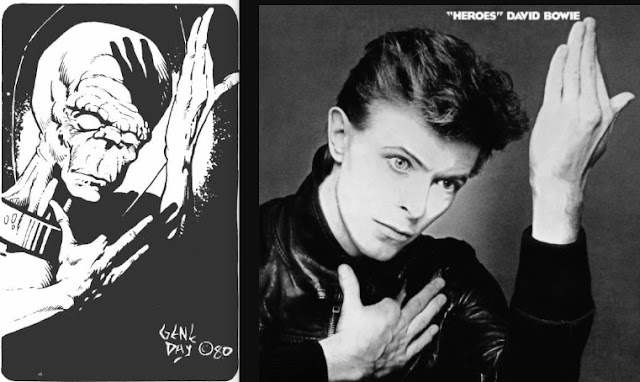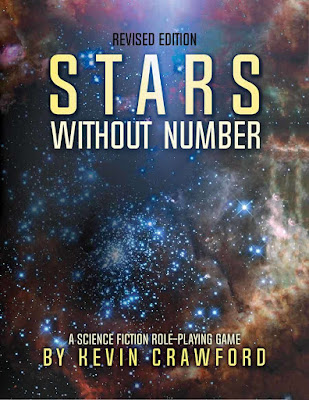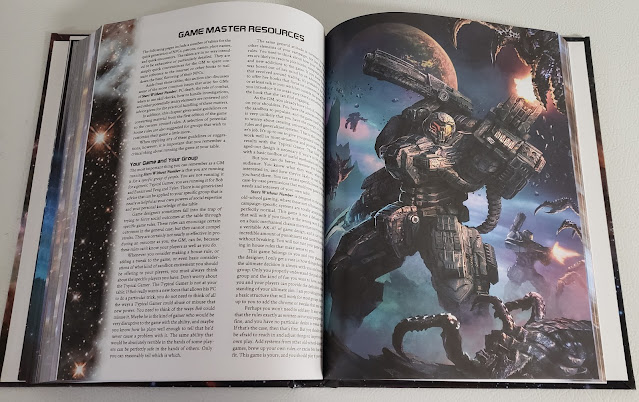Space Opera has always been one of those games that I have wanted for years but never tried. Anytime I thought about the game it was usually out of print and the prices were a bit high. Then I'd forget about it again. Reading through all my old Dragons, especially in the 1980-1983 time frame, there was an ad for it every issue.
Since this is SciFi month I figure I should go back to this one. Thankfully for me, it is now available as a PDF from DriveThruRPG.
Space Opera (1982)
Space Opera, 1st Edition, was released in 1980 which makes it one of the first competitions to the Classic Traveller RPG. The 2nd Edition version, which is what DriveThruRPG has, was released in 1982. I can't really speak to the differences. According to a post over at Wayne Books, there are not really many differences between the 1st Ed "Blue" box vs. the 2nd Ed. "Black" box save for the art.
There also seems to be a slight difference between the two black box 2nd edition covers.
Space Opera was written by Edward E. Simbalist, A. Mark Ratner, and Phil McGregor and published by Fantasy Games Unlimited.
The PDF from DriveThruRPG is 200 pages split into to two volumes. There are two color pages of the box art and the rest is a very old-school style b/w text with some minimal art. While this sounds like a drawback the game is very much a sandbox-style game. So the "Art" that would be here is from whatever your favorite sci-fi property is. Space Opera tries to be all things to everyone and ... well we will see how well it does at this. The PDF is a scanned image, then OCR'ed. There is no bookmarking.
Out of the box we learn that Space Opera is exactly that. A game to emulate your favorite Space Opera fiction. This is not the hard science of Traveller or the weird science of Gamma World/Metamophasis Alpha. This is Star Wars, Battlestar Galactica, Buck Rogers. I have heard it described as "not drama, but melodrama."
The sections are numbered like many old-school war games. 1.0 is "Space Opera" 1.1 is "Required Materials & Equipment" and so on. There are four major sections of Vol. 1, the player's book, 1. Space Opera, the introduction, 2. Character classes, 3. PC Career Experience and 4. PC Knowledge and Skills. Vol. 2 is the "Star Master's" section. Yes they are indeed called Star Masters. Here we have sections 5 to 18. 5. General Equipment Lists, 6. Personal Weapons, 7. Heavy Weapons, 8. Ground Combat, 9. StarShips, 10. StarShip Combat, 11 StarShip Economics & Interstellar Comerce, 12. World Creation, 13. Cultural Contacts (aka Aliens), 14. Directory Design of Planets, 15. Habitable Planets, 16. NPC Races, 17. Beasts, and finally 18. Personal Living Expenses.
If it looks like the game is heavy on weapons and combat then yes, it is. It is also so wonderful old school with bunches of different systems and sub systems.
Instead of completely reviewing a 40+ year old game let through out some caveats and some points.
First, while this game was certainly an attractive alternative to Traveller at the time, we have many more games out now that do this all better and with clearer rules.
Second, if you are a fan of older games or a fan of Sci-Fi games then really is a must have for your collection. The PDF is nice and cheap compare to the $100+ to $300 range I see copies go for online. For $10.00 it is worth your while if you are curious about the game, the history of RPGs or Sci-Fi games.
Now some points. Or how to get the most out of the 10 bucks I just asked you to spend.
Section 1.2 covers units of measurement, all metric focused. Many games do not have these, this is useful for anyone working in three-dimensions or needs a good idea what a cubic meter is.
Section 1.4 has good advice on dicing rolling in any game. Don't roll unless the outcome is in question or it serves the drama. There are lots of time to roll the dice, it doesn't need to be done all the time.
Section 2.0 covers classes. They boil down to Fighting, Tech, Science, Medical and Specialist. We will see these in one form or another time and time again in nearly every other Sci-Fi RPG from Stars Without Number, The Expanse, to Starfinder and even Star Wars and Star Trek.
Section 2.2 is a nice overview and random tables of Planet of Birth. They are all d20 rolls and should work with every other system out there. My back of the napkin math even tells me it would work great in such games like White Star.
Section 2.3 character races has great guidelines for just about every sci-fi race out there. Humans, future humans, evolved apes, cats, dogs, bears, birds, lizards. All here. Again guidelines so cut and paste into what other Sci-Fi game you have going on. No giant insects though.
Section 3.1 on covers some great guidelines on Mercenary service. I can't vouch that the economics will transfer from game to game though.
Section 4 has so many skills. I prefer a simpler skill system these days, but this would help you define some specialized ones.
Section 4.10 has a lot of Psionic skills as well. Might work with Stars Without Number. This is also how you get "The Force" without pissing off Lucasfilm/Disney.
Also if your Sci-Fi RPG does not have at least one David Bowie tribute then you are doing it wrong.
Section 5. So. Much. Equipment!
Section 15. Great toolkit for habitable planets.
Section 16. NPCs and sample Alien races.
I said above it tries to be everything to everyone. It does this by taking every sci-fi trope there is and giving it a home here. Does it work? Well...it ends up being very long, very complicated and somewhat unattractive, but I can't tell if I am judging it by today's standards, my standards for game design or the standards of the time. This is a toolkit game with 1000s of options and you only need to choose the ones that work best for you.
This is not the Granddaddy of Sci-Fi RPGs. That would be Traveller. This is however the Great Uncle. He still has some good ideas and since he has no kids of his own he can spoil the grandkids as much as he likes.
I am sure that there are groups out there still today that would LOVE this game. Me I prefer something a little more streamlined. That all being said, I am glad I bought the PDF of this as opposed to spending $100s on eBay for it.



























